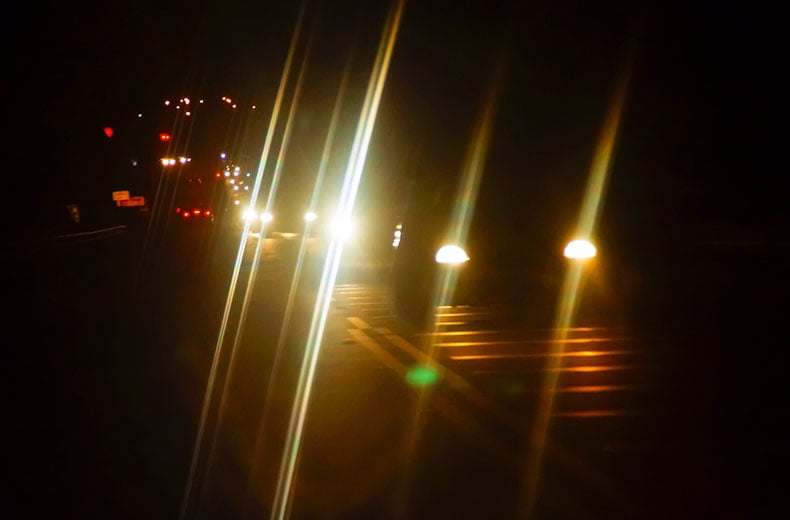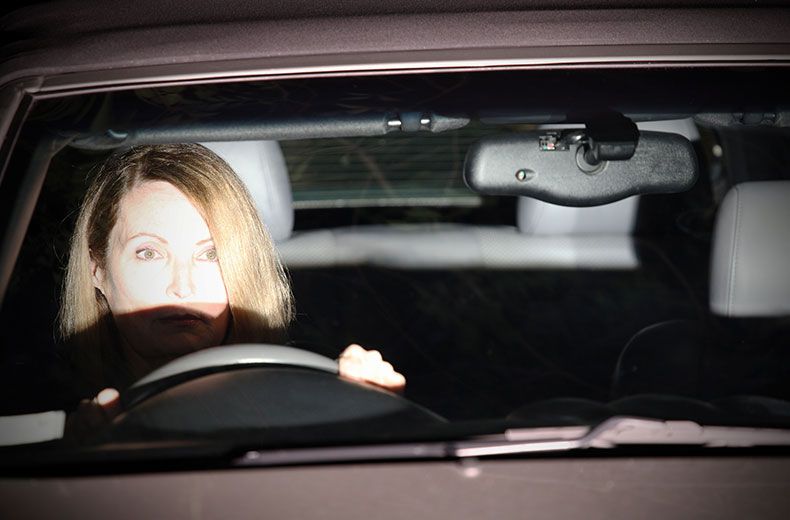What is headlight dazzle?
Headlight dazzle is caused by a headlight’s beam having a blinding effect for oncoming traffic. You've probably been exposed to this distressing and potentially dangerous aspect of motoring whilst driving at night.
It is experienced by an estimated 16.1m UK drivers, based on 91% of drivers responding saying ‘some’ or ‘most’ car headlights are too bright and 54% of these saying they are dazzled more regularly now than a year ago.
When asked how they are affected by headlight glare, six-in-10 of those affected said they regularly get dazzled by oncoming headlights even though they are dipped, with a similar proportion (60%) being unable to tell if headlights are either dipped or on full beam. Forty-five per cent complained they get dazzled by headlights in their rear-view mirror, while a huge 70% believe some lights are so bright they represent an accident risk. In fact official government data shows there are around 300 collisions every year where dazzling headlights are a factor.
RAC spokesperson Rod Dennis said:
“The dazzling effect of another driver’s headlights isn’t just uncomfortable – in some cases it can be nothing short of dangerous, making us lose sight of the road for a short time. So it’s concerning to see that a greater proportion of drivers have reported problems with glare this year than last year."
What causes headlight dazzle?

Drivers were less clear on the likely causes of glare. Half (51%) blamed vehicles that sit higher on the road, such as increasingly popular SUVs, for dazzling them although 41% said the problem was not caused by any particular type of vehicle.
Similarly, when it comes to lighting technologies, 55% believe ‘bluer’ xenon or the most modern LED headlights are to blame, but a similar number (51%) are not sure or can’t tell the difference between the types of lights.
"Among some drivers there is a perception that newer headlights cause more glare. But while a sizeable proportion claim it is the xenon headlights more often found in higher-end vehicles that are primarily to blame, a greater proportion either don’t know the difference between lights or aren’t sure." - Rod Dennis, RAC spokesman
“In reality, the issue of glare is a complex one and it’s not as straightforward as saying one type of lightbulb causes more of a dazzling effect than another – there are a range of reasons why a driver might be dazzled, from a slight misalignment of a headlight, the difference in ride height of different vehicles and even individual people’s vision. That explains why not every car headlight appears to be dazzling, with eight-in-10 drivers saying only some cause glare."
- 10 driving offences you didn’t know were illegal
- Daytime running lights: everything you need to know
- Parking lights - what are they and should I use them?
- Blinded by the lights – nearly one-in-four drivers think most car headlights are too bright
The research also found that in some cases drivers themselves might be inadvertently causing glare – either by not adjusting their lights correctly, or by having badly-aligned lights. Forty-seven per cent of drivers either never adjust their car headlights up or down when carrying different loads, or don’t do it regularly enough – something that is important in avoiding causing other people to suffer from glare as the aim of the headlight beam is affected by the load in the vehicle.
A quarter of drivers (26%) meanwhile have suspected problems with a misaligned headlight, with 9% of this group either trying to sort the problem out themselves or ignoring it altogether – all of these scenarios are likely to lead to a dazzling effect that could cause other road users discomfort.
Headlamp aim forms part of a vehicle’s MOT, and the requirements on garages to conduct this part of the test thoroughly were strengthened in 2016. Nonetheless, figures obtained by the RAC from the Driving and Vehicle Standards Agency (DVSA) show that of the 26.5m MOT tests completed in 2018 for Class 4 vehicles (which includes cars) over three years of age, 6% still failed as result of problems with headlamp aim, the equivalent of nearly 1.6m vehicles.** In 2016, the agency also stated that ‘headlamp aim consistently tops the MOT compliance survey as one of the most likely items to be assessed incorrectly by testers.’

Cheaper than AA or we’ll beat by 20%^
• Roadside cover from £5.49 a month*
• We get to most breakdowns in 60 mins or less
• Our patrols fix 4/5 breakdowns on the spot
*At least 10% of new customers pay this for single-vehicle Roadside (Basic). ^Find the same cover cheaper on theaa.com within 7 days & we'll beat it by 20%. T&Cs here.

Are bright headlights illegal?
No, but the majority of surveyed drivers were concerned with the aging regulation surrounding headlights.
“All headlights have to meet specific international standards, which motorists might be surprised to discover haven’t been updated since the 1960s and so do not take specific account of newer technologies like xenon and LED. And an overwhelmingly proportion of drivers – 84% – now want the UK Government to act to ensure the regulations are updated to remove the possibility of glare being a result of modern technology.” - Rod Dennis, RAC spokesman.
I get dazzled by headlights – what can I do?
Get glare reducing glasses
Taking to your optician would be a great first step if you wear glasses. A coating can be added that can go some way towards making it easier to see when you are faced with car headlights. A quarter (25%) of respondents to the RAC survey wear such glasses.
Use your rear-view mirror anti-glare switch
Unless your car has a self-dimming rear-view mirror, you can reduce glare from vehicles behind you by adjusting your rear-view mirror more often – more than half (56%) of drivers who responded to the survey say they do this.
Get an auto-dimming rear-view mirror
When changing your car, look for one with an auto-dimming rear-view mirror and even darkened glass (sometimes called ‘sunset glass’) when you next change your car. Both can be effective at reducing the bright light that reaches you.
Am I causing headlight glare myself?
- Check to see if your car automatically levels its headlights depending on the load you are carrying –the vast majority of cars on the road don’t
- If you don’t have automatically levelling headlights, always manually adjust them depending on the load you are carrying and according to the car’s manual. A single person driving with an empty boot needs a different setting compared to a single person plus a boot-load of luggage, or all five seats occupied and a fully-loaded boot
- Ask to have the angle of your car’s headlights checked next time you have it serviced to ensure the beam is being directed properly
** Freedom of Information request made to DVSA in April 2019






